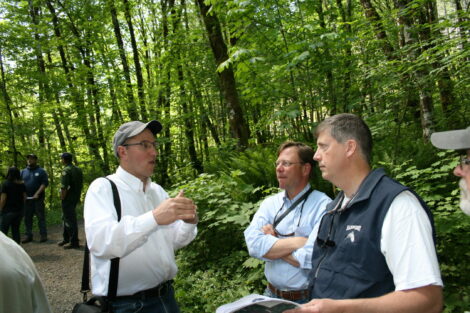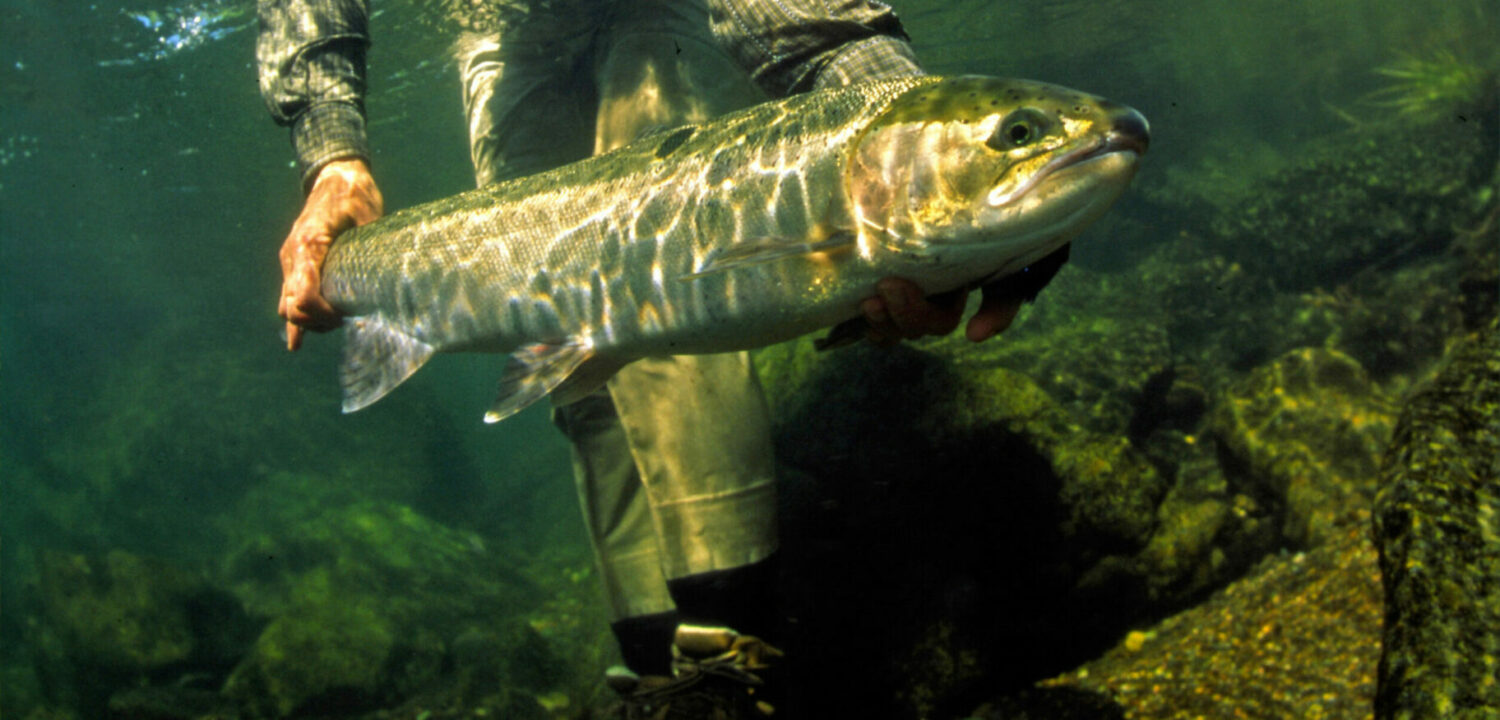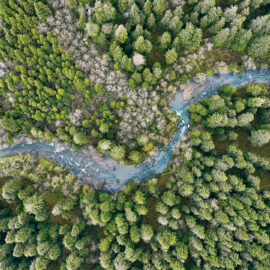With balanced state forest management in Oregon at risk, groups step up to represent diverse interests, make motion to dismiss Linn County lawsuit against state.
Wild Salmon Center, Pacific Rivers, Association of Northwest Steelheaders, and Northwest Guides and Anglers Association yesterday filed a motion to intervene in a lawsuit brought in January by Linn County against the State of Oregon and the Oregon Department of Forestry. The groups filed to join in a Motion to Dismiss filed by the State of Oregon on the same day.
The Linn County lawsuit seeks $1.4 billion in alleged damages from the State of Oregon for not maximizing revenue from state-owned and managed forestlands. For decades, the state has sought a varied and balanced mix of management approaches that produce timber revenue, provide for conservation of watersheds, and recreation. Linn County claims the state was required to maximize industrial timber harvest for the counties to the exclusion of other values.
The conservation and fishing interests intervened in order to demonstrate that state law and the history of the lands clearly support the approach the state adopted in 1998. Oregon statutes require the lands to be managed for the “greatest permanent value of those lands to the state.” The rules adopted in 1998 allow management for salmon and wildlife habitat protection, recreation interests, and clean water procurement, as well as timber production.
A state attorney general opinion in 2006 concluded the state does not have a contractual duty to elevate timber payments above other priorities, when managing state forests. The Oregon Supreme Court has also previously declined to characterize the state’s obligation as a contract, but has instead looked to the terms of state law to determine the state’s obligation.

Bob Rees, a professional fishing guide and board member of the Northwest Guides and Anglers Association, noted the importance of state forests to the fishing industry. “Our fisheries have paid a high price for decades for industrial logging in the past, and great progress has been made to put our public lands on a more sustainable path for all the values Oregonians hold dear,” said Rees. “We can’t sacrifice our fisheries and fishing jobs for unsustainable timber harvests.”
“The law is clear: State forests belong to all Oregonians and the state is required to balance timber production with other values on state forest land,” said Bob Van Dyk, the Oregon and California policy director at Wild Salmon Center. “These lands came into state ownership because they were degraded and abandoned by private timber companies decades ago. Oregonians paid to reforest and protect the lands. Taxpayers don’t have to write huge checks to county governments simply because the state decided to include some modest measures for salmon and recreation.”
Ralph Bloemers, staff attorney with the Crag Law Center, is representing the conservation and fishing interests in the case. He said: “There are huge gaps in Linn County’s complaint, which fails to even mention that for over fifty years state law has noted the importance of fisheries, wildlife, and watershed protection, erosion control, and recreation. There is no sound legal basis for Linn County to seek 1.4 billion dollars in additional payments from the people of Oregon and for this reason the groups have moved to dismiss the case.”
John Kober, executive director at Pacific Rivers, noted the politics behind the lawsuit. “It should come as no surprise that the timber industry is helping to pay for this lawsuit. This is a re-run of an old Oregon story: the timber industry using their influence to extract resources from public land for their own private benefit.”
Ian Fergusson, who serves on the board of the Association of Northwest Steelheaders, noted that the lawsuit threatened to undermine years of effort to find a balanced approach to forest management. “Our group has been working with the citizen-members of the Board of Forestry to balance timber interests with fish conservation and other values. This lawsuit threatens to derail efforts to find collaborative solutions that protect the salmon and steelhead that spawn and rear in state forest waters. The main reason coho salmon are still on the threatened species list is because freshwater habitat on the North Coast is badly degraded. More logging, more roads, and more herbicide spraying will only make it worse.”
Legal details
In yesterday’s filing, the conservation and fishing groups joined in a motion to dismiss the case that the State of Oregon filed. The State of Oregon and the groups argue that the Linn County Circuit Court lacks jurisdiction to hear Linn County’s claims and that any challenge to the GPV Rule must be made in the Oregon Court of Appeals. Linn County must demonstrate that the State exceeded its authority under the rules. Further, the State of Oregon seeks dismissal because Linn County has failed to state a claim upon which relief can be granted. State law does not permit Counties to sue the State of Oregon for damages, nor does State law provide any support for Linn County’s allegation that the State of Oregon must maximize revenues from state forestlands and ignore fisheries, wildlife, recreation and the other values explicitly recognized in State law.
Background
The dispute in this lawsuit can be tied back to an Oregon Board of Forestry decision in 1998 to seek a balanced approach on a class of state forests that now total more than 700,000 acres. The 1998 decision has had, according to Linn County, “devastating effects on local communities“ and caused unemployment to “skyrocket.” Subsequent reports since the lawsuit was filed have suggested that timber revenue from state forests in Linn County “is about half of what it was in the 1990s.”
The story is actually just the opposite. Timber revenue is not half what it was in the 1990s, because the adoption of the new rule in 1998 led directly to substantial harvest increases. The 1998 rule grew from changing public expectations of how forests should be managed. First, federal law identified endangered species that needed protection. Second, recreational use of state forests was starting to boom, especially in the Tillamook State Forest, west of the Portland metro area. Oregon did not have a comprehensive plan to manage these forests according to these changing expectations. The state risked lawsuits without a detailed and science-based guidance document.
Fortunately, Oregon law clearly allows state forests to accommodate multiple values. State law says these forests should be managed “to secure the greatest permanent value … to the state.” This law specifically identifies multiple uses, such as providing for fish and wildlife, protecting drinking water, protection against floods and erosion, and allowing recreation, as well as timber sales. No hierarchy of uses is mandated.
Through collaborative planning, the state responded to the new demands in the 1990s by developing detailed plans. The Board of Forestry sought high timber harvest levels while also protecting salmon streams, restoring lands damaged by earlier timber practices, managing recreation and protecting critical wildlife habitat. It was not an easy balance to find. The result was a dramatic increase in harvest levels. In Linn County, the level of timber harvest doubled in the 15 years after 1998, compared to the previous 30 years. Rather than causing “economic devastation,” the state forests became a reliable economic engine.
The majority of the lands at issue in the suit are in Tillamook, Clatsop, and Washington counties in Northwest Oregon. State Forest planners and the Oregon Department of Fish and Wildlife have identified a set of Aquatic Anchor Habitats on state forests to help conserve the valuable salmon fisheries on the north coast.
In the current state forest plan, 55% of the landscape is devoted to clear cutting and roads, 18% is open to thinning and road construction, and 27% is dedicated to stream protection, protecting steep and rocky slopes, and habitat for endangered species. Meanwhile, demand for forest recreation opportunities continues to rise in growing counties such as Washington and Clatsop.
______________________________________________________________________________
Media Contact:
Oakley Brooks, Wild Salmon Center, obrooks@www.wildsalmoncenter.org, (c) 503.307.3927
Sources:
Bob Van Dyk, bvandyk@wildsalmoncenter.org (c) 503.504.8471
John Kober, john@pacificrivers.org, (w) 503-228-3555, (c) 503-915-6677




